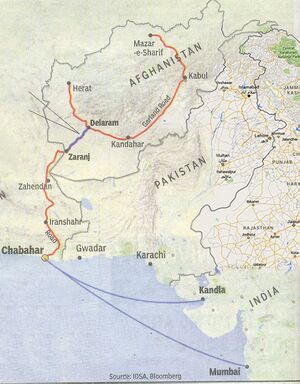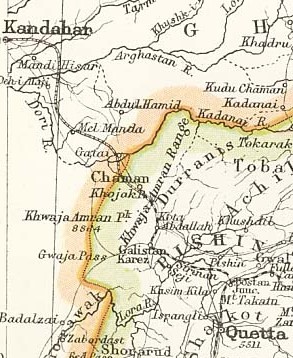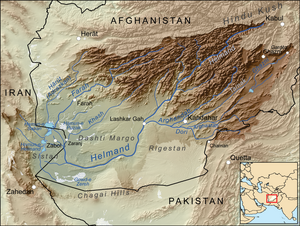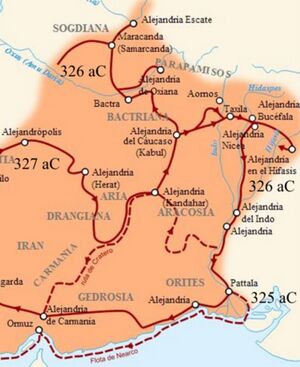Kandahar
| Author:Laxman Burdak, IFS (Retd.) |



Kandahar (कन्दहार) is a town in Afghanistan. It is the second-largest city in Afghanistan.
Variants
- Kandahār (/ˈkændəˌhɑːr/) or Qandahār (Pashto: کندهار; Dari: قندهار; known in older literature as Candahar)
- Khnenta (ख्नेन्त) was ancient Kandahar (कन्दहार). [1]
Founder
Location
Kandahar is located in the south of the country on the Arghandab River, at an elevation of 1,010 m. It is the capital of Kandahar Province, and also the center of the larger cultural region called Loy Kandahar.
History
In 1709, Mirwais Hotak made the region an independent kingdom and turned Kandahar into the capital of the Hotak dynasty. In 1747, Ahmad Shah Durrani, founder of the Durrani dynasty, made Kandahar the capital of the Afghan Empire.[2][3]
Kandahar is one of the most culturally significant cities of the Pashtuns and has been their traditional seat of power for more than 300 years. It is a major trading center for sheep, wool, cotton, silk, felt, food grains, fresh and dried fruit, and tobacco. The region produces fine fruits, especially pomegranates and grapes, and the city has plants for canning, drying, and packing fruit, and is a major source of marijuana and hashish en route to Tajikistan.
The region around Kandahar is one of the oldest known human settlements. A major fortified city existed at the site of Kandahar, probably as early as c. 1000-750 BCE,[4] and it became an important outpost of the Achaemenid (Persian) Empire in the 6th century BCE.[5] Alexander the Great had laid-out the foundation of what is now Old Kandahar in the 4th century BC and gave it the Ancient Greek name Αλεξάνδρεια Aραχωσίας (Alexandria of Arachosia). Many empires have long fought over the city due to its strategic location along the trade routes of southern, central and western Asia. Since the 1978 Marxist revolution, the city has been a magnet for groups such as Haqqani network, Quetta Shura, Hezbi Islami, al-Qaida and other terrorist groups. From late-1996 to 2001, it served as the de facto capital of the Taliban government until the Taliban were overthrown by US-led NATO forces during Operation Enduring Freedom in late-2001 and replaced by the government of President Hamid Karzai.
Prehistory: Excavations of prehistoric sites by archaeologists such as Louis Dupree and others suggest that the region around Kandahar is one of the oldest human settlements known so far.
Early peasant farming villages came into existence in Afghanistan ca. 5000 B.C., or 7000 years ago. Deh Morasi Ghundai, the first prehistoric site to be excavated in Afghanistan, lies 27 km (17 mi) southwest of Kandahar (Dupree, 1951). Another Bronze Age village mound site with multiroomed mud-brick buildings dating from the same period sits nearby at Said Qala (J. Shaffer, 1970). Second millennium B.C. Bronze Age pottery, copper and bronze horse trappings and stone seals were found in the lowermost levels in the nearby cave called Shamshir Ghar (Dupree, 1950). In the Seistan, southwest of these Kandahar sites, two teams of American archaeologists discovered sites relating to the 2nd millennium B.C. (G. Dales, University Museum, University of Pennsylvania, 1969, 1971; W, Trousdale, Smithsonian Institution, 1971 – 76). Stylistically the finds from Deh Morasi and Said Qala tie in with those of pre-Indus Valley sites and with those of comparable age on the Iranian Plateau and in Central Asia, indicating cultural contacts during this very early age. — N. Dupree, 1971[6]
British excavations in the 1970s discovered that Kandahar existed as a large fortified city during the early 1st millennium BCE; while this earliest period at Kandahar has not been precisely dated via radiocarbon, ceramic comparisons with the latest period at the major Bronze Age city of Mundigak have suggested an approximate time-frame of 1000 to 750 BCE.[7] This fortified city became an important outpost of the Achaemenid Empire in the 6th to 4th centuries BCE, and formed part of the province of Arachosia.[8]
Alexandria

The now "Old Kandahar" was founded in 330 BC by Alexander the Great, near the site of the ancient city of Mundigak (established around 3000 BC). Mundigak served as the provincial capital of Arachosia and was ruled by the Medes followed by the Achaemenids until the arrival of the Greeks from Macedonia. The main inhabitants of Arachosia were the Pactyans, an ancient Iranian tribe, who may be among the ancestors of today's Pashtuns. Kandahar was named Alexandria, a name given to cities that Alexander founded during his conquests.[9]
Kandahar has been a frequent target for conquest because of its strategic location in Southern Asia, controlling the main trade route linking the Indian subcontinent with the Middle East and Central Asia.[10] The territory became part of the Seleucid Empire after the death of Alexander. It is mentioned by Strabo that a treaty of friendship was established eventually between the Greeks and the Mauryans (Indians).[11][12] The city eventually became part of the Greco-Bactrian Kingdom (250 BC-125 BC), and continued that way for two hundred years under the later Indo-Greek Kingdom (180 BC – 10 CE). King Menander I (165 BC – 135 BC) of the Indo-Greek Kingdom practiced Greco-Buddhism and is recorded by the Mahavamsa (Chap. XXIX) to have sent "a Greek ("Yona") Buddhist head monk" named Mahadharmaraksita (literally translated as 'Great Teacher/Preserver of the Dharma') with 30,000 Buddhist monks from "the Greek city of Alasandra" (possibly Alexandria in Arachosia, as Kandhar was known under the Greeks) to Sri Lanka for the dedication of Great Stupa Buddhist temple in Anuradhapura. (See also Milinda Panha.)
While the Diadochi were warring amongst themselves, the Mauryans were developing in the northern part of the Indian subcontinent. The founder of the empire, Chandragupta Maurya, confronted a Macedonian invasion force led by Seleucus I in 305 BC and following a brief conflict, an agreement was reached as Seleucus ceded Gandhara and Arachosia and areas south of Bagram to the Mauryans. During the 120 years of the Mauryans in southern Afghanistan, Buddhism was introduced and eventually become a major religion alongside Zoroastrianism and local pagan beliefs. The ancient Grand Trunk Road was built linking what is now Kabul to various cities in the Punjab and the Gangetic Plain. Commerce, art, and architecture (seen especially in the construction of stupas) developed during this period. It reached its high point under the Mauryan Emperor Ashoka whose edicts, roads, and rest stops were found throughout the subcontinent. Although the vast majority of them throughout the subcontinent were written in Prakrit, Afghanistan is notable for the inclusion of 2 Greek and Aramaic ones alongside the court language of the Mauryans.
Kandahar Bilingual Rock Inscription (Greek and Aramaic) by Emperor Ashoka, from Chilzina in Kandahar, 3rd century BC.
Inscriptions made by Emperor Ashoka, a fragment of Edict 13 in Greek, as well as a full Edict, written in both Greek and Aramaic has been discovered in Kandahar. It is said to be written in excellent Classical Greek, using sophisticated philosophical terms. In this Edict, Ashoka uses the word Eusebeia ("Piety") as the Greek translation for the ubiquitous "Dharma" of his other Edicts written in Prakrit:
- Ten years (of reign) having been completed, King Piodasses (Ashoka) made known (the doctrine of) Piety (εὐσέβεια, Eusebeia) to men; and from this moment he has made men more pious, and everything thrives throughout the whole world. And the king abstains from (killing) living beings, and other men and those who (are) huntsmen and fishermen of the king have desisted from hunting. And if some (were) intemperate, they have ceased from their intemperance as was in their power; and obedient to their father and mother and to the elders, in opposition to the past also in the future, by so acting on every occasion, they will live better and more happily. — Trans. by G.P. Carratelli
The last ruler in the region was probably Subhagasena (Sophagasenus of Polybius), who, in all probability, belonged to the Ashvaka (q.v.) background.
Islamization and Mongol invasion
In the 7th century AD, Arab armies conquered the region with the new religion of Islam but were unable to succeed in fully converting the population. In AD 870, Yaqub ibn Layth Saffari, a local ruler of the Saffarid dynasty, conquered Kandahar and the rest of the nearby regions in the name of Islam.
Arab armies carrying the banner of Islam came out of the west to defeat the Sasanians in 642 AD and then they marched with confidence to the east. On the western periphery of the Afghan area the princes of Herat and Seistan gave way to rule by Arab governors but in the east, in the mountains, cities submitted only to rise in revolt and the hastily converted returned to their old beliefs once the armies passed. The harshness and avariciousness of Arab rule produced such unrest, however, that once the waning power of the Caliphate became apparent, native rulers once again established themselves independent. Among these the Saffarids of Seistan shone briefly in the Afghan area. The fanatic founder of this dynasty, the coppersmith's apprentice Yaqub ibn Layth Saffari, came forth from his capital at Zaranj in 870 AD and marched through Bost, Kandahar, Ghazni, Kabul, Bamiyan, Balkh and Herat, conquering in the name of Islam. — N. Dupree, 1971[13]
It is believed that the Zunbil dynasty, who were related to the Shahi dynasty of Kabul, were probably the rulers of the Kandahar region from the 7th century until the late 9th century AD.[20] Kandahar was taken by Sultan Mahmud of Ghazni in the 11th century followed by the Ghurids of Ghor. The region was invaded in the 13th century by Genghis Khan and his Mongol armies, who caused destruction but did not settle. It became part of the lands of the Timurids from the 14th century to the 15th century, a dynasty founded by Timur (Tamerlane) that began rebuilding cities and towns. Kandahar was described by Ibn Battuta in 1333 as a large and prosperous town three nights journey from Ghazni.[14]
Pir Muhammad, a grandson of Tamerlane, held the seat of government in Kandahar from about 1383 until his death in 1407. Following his death, the city was ruled by other Timurid governors. Kandahar was entrusted to the Arghuns in the late 15th century, who eventually achieved independence from the Timurids. Guru Nanak, the founder of Sikhism, is believed to have visited the town (c. 1521 AD) during his important journey between Hindustan and Mecca in Arabia.
Tamerlane's descendant, Babur, the founder of the Mughal Empire, annexed Kandahar in 1508. In 1554, Babur's son, Humayun, handed it over to the Safavid Shah Tahmasp in return of 70,000 soldiers he received from the Shah to reconquer India. In 1595, Humayun's son Akbar the Great conquered the city by diplomacy. Akbar died in 1605 and when this news reached the Persian court, Shah Abbas ordered his army to besiege the city which continued until early 1606 and finally failed due to the reinforcements send by the Mughal Emperor Jahangir forced the Safavid retreat. In the Mughal–Safavid War, Kandahar was once again lost to the Safavids. Kandahar was regarded as important to the Mughal Empire because it was one of the gateways to India, and Mughal control over Kandahar helped to prevent foreign intrusions.[15]
The memory of the wars fought over Kandahar at this time is preserved in the epic poem Qandahār-nāma ("The Campaign Against Qandahār"), a major work of Saib Tabrizi which is a classic of Persian literature.
External links
References
- ↑ परोपकारी, अप्रेल प्रथम 2019, s.n. 9, p.6
- ↑ "Kandahar". Columbia Encyclopedia.
- ↑ "The City of Kandahar". Columbia Encyclopedia. Archived from the original on 15 May 2011.
- ↑ F.R. Allchin (ed.), The Archaeology of Early Historic South Asia: The Emergence of Cities and States (Cambridge University Press, 1995), pp.127-130
- ↑ Gérard Fussman, "KANDAHAR ii. Pre-Islamic Monuments and Remains", in Encyclopædia Iranica, online edition, 2012
- ↑ Dupree, Nancy Hatch (1970). An Historical Guide to Afghanistan. First Edition. Kabul: Afghan Air Authority, Afghan Tourist Organization. p. 492
- ↑ F.R. Allchin (ed.), The Archaeology of Early Historic South Asia: The Emergence of Cities and States (Cambridge University Press, 1995), pp.127-130
- ↑ Gérard Fussman, "KANDAHAR ii. Pre-Islamic Monuments and Remains", in Encyclopædia Iranica, online edition, 2012
- ↑ Lendering, Jona. "Alexandria in Arachosia". LIVIUS – Articles on Ancient History.
- ↑ Mentioned in Bopearachchi, "Monnaies Greco-Bactriennes et Indo-Grecques", p52. Original text in paragraph 19 of Parthian stations
- ↑ Nancy Hatch Dupree / Aḥmad ʻAlī Kuhzād (1972). "An Historical Guide to Kabul – The Story of Kabul". American International School of Kabul.
- ↑ Lendering, Jona. "Maurya dynasty". LIVIUS – Articles on Ancient History.
- ↑ Dupree, Nancy Hatch (1970). An Historical Guide to Afghanistan. First Edition. Kabul: Afghan Air Authority, Afghan Tourist Organization. p. 492
- ↑ Ibn Battuta (2004). Travels in Asia and Africa, 1325–1354 (reprint, illustrated ed.). Routledge. p. 179. ISBN 0-415-34473-5.
- ↑ Sen, Sailendra (2013). A Textbook of Medieval Indian History. Primus Books. pp. 151, 162, 169–170. ISBN 978-93-80607-34-4.

